Nucleotide sequencing has become a very popular technique for diagnosis and characterization of pathogens and is accessible to most veterinary practices.
A nucleotide sequence provides information on the nature of the pathogen, its source and its main characteristics such as strain, virulence and drug resistance.
Bioinformatics provides tools to gather, store, and analyse these biological sequences, by dissecting and interpreting biological data from different organisms
The Food and Agriculture Organization of the United Nations (FAO) and the International Atomic Energy Agency (IAEA) in collaboration with the Swiss Institute of Bioinformatics (SIB) have developed a new e-learning course on bioinformatics of animal viruses to improve prevention and control of animal diseases.
The first module entitled "Phylogenetics of Animal Pathogens: Basic Principles and Applications" was released in 2013. Designed as a self-learning module for animal health laboratory staff, it is organized in four chapters: 1) basic notions on phylogenetic trees; Book by Isaac Salazar
2) how to build phylogenetic trees; 3) how to interpret phylogenetic trees, and 4) exercises. Many examples are included such as influenza, Foot-and-Mouth Disease and Peste des Petits Ruminants viruses. The entire course can be completed in approximately 4 hours.

The second module, entitled “BLAST and Multiple Sequence Alignment (MSA) Programs” was released in May 2014. This module is subdivided into two parts that outline two of the main bioinformatics tools that help with the analysis of large sequences: Basic Local Alignment Search Tool (BLAST) and Multiple Sequence Alignment (MSA). This new module requires approx. 2 hours to complete the BLAST chapter and 2 more hours are needed to complete the MSA chapter.
BLAST is an algorithm that compares nucleotide or protein sequences to millions of known entries in sequence databases and calculates the statistical significance of matches. BLAST can be used to infer functional and evolutionary relationship between sequences as well as help identify members of gene families. The self-learning chapter on BLAST includes: 1) basic notions on public databases; 2) notions on sequence similarity search; 3) a description of scoring systems; 4) a FastA/ BLAST sequence alignment programme; 5) a BLAST algorithm; and 6) how to interpret BLAST results.
MSA algorithms perform the precise alignment of three or more biological sequences and can be run on nucleotide or protein sequences. The output of MSA applications is used to study homology and the evolutionary relationship of the sequences. Visual depictions of the alignment highlight mutation events such as point mutations, and insertion or deletion mutations. The self-learning chapter on MSA includes: 1) a description of the pairwise alignment scoring system; 2) summary of the differences between global versus local alignments; 3) multiple alignment methods; 4) description of several MSA programmes; 5) how to edit alignments; and 6) software recommendations.
Several quizzes are available for self-assessment after each module step.
All modules are accessible via a dedicated website and can also be distributed on CD-ROM and USB key, and further information can be obtained from FAO: EMPRES-Animal-Health@fao.org or SIB: e-learning@isb-sib.ch.
CABI comprehensively covers international scientific literature on all aspects of viral diseases of wild and domestic animals. Its CAB Abstracts Database contains approximately 100,000 scientific records with abstracts on techniques for diagnosis of viral pathogens in animals, and over 9500 records on bioinformatics.
Related News & Blogs
CABI shares expertise in digital extension and advisory services at FAO workshop
CABI has shared its expertise in digital agricultural and advisory services for smallholder farmers as part of Food and Agriculture Organization of the United Nations (FAO)-led capacity building workshop. Dr Monica Kansiime and Rahab Njunge, who are bo…
26 July 2022



